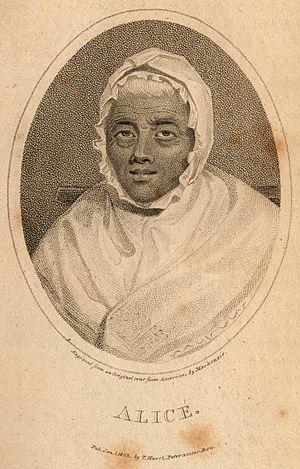Alice of Dunk's Ferry facts for kids
Alice of Dunk's Ferry was an amazing African-American woman who lived a very long life, from about 1686 to 1802. She was known for being a "centenarian," which means she lived to be over 100 years old. Alice was also a "toll collector" and a special kind of historian called an "oral historian." This means she shared stories and history by speaking, not by writing.
Alice's Early Life
Alice was born around 1686 in Philadelphia, Pennsylvania. Her parents were also enslaved people who had been brought to America from Barbados. When Alice was about ten years old, she was moved from Philadelphia to a place called Dunk's Ferry. This spot was in Bucks County, about seventeen miles up the Delaware River. She lived there for the rest of her life.
For forty years, Alice worked at Dunk's Ferry. Her job was to collect money, called "tolls," from people who wanted to cross the river. She worked for a man named Samuel Carpenter, who was a friend of William Penn. William Penn was the person who founded Pennsylvania.
Alice: A Living History Book
Alice became very well-known as 'Alice of Dunk's Ferry'. People loved her because she was lively and enjoyed sharing her memories. She had seen Philadelphia grow from a small river settlement into the capital of a new nation. This made her a celebrated local historian.
People respected Alice as an oral historian. They loved to hear her vivid stories about people, places, and events. She remembered when Philadelphia was mostly wilderness. She could tell stories about Native Americans hunting in the woods. She also spoke of wild animals like panthers and wolves roaming near the homes.
Even though Alice could not read or write, she loved to have the Bible read to her. People trusted her stories because she was known for always telling the truth. It is even said that Alice lit the pipe for William Penn himself! She also met another important person named Thomas Story.
A writer named Isaiah Thomas wrote about Alice. He said she was a smart woman with a good memory. She would often talk about how much the city and country had grown. Her conversations were very interesting, especially to the families of the first settlers. She often shared fun stories about their ancestors.
Her Later Years and Legacy
When Alice was between 96 and 100 years old, she slowly lost her eyesight. But even when she was blind, she was still good at catching fish! She was a very active person and "could not be idle." Around the age of 102, her eyesight actually started to come back. She could see moving things, but she couldn't tell people apart.
Isaiah Thomas wrote that before she died, Alice's hair turned completely white. Her last teeth fell out when she was 116 years old. She is believed to have been that age when she passed away in 1802 in Bristol, Pennsylvania.
Today, people are working to share Alice's story. They want to remember the history of slavery. Christ Church, Philadelphia, where Alice worshipped her whole life, is one of the places doing this. It's said that Alice would ride her horse to Christ Church every Sunday, even at 95 years old!
There is now a granite monument at the spot of Dunk's Ferry. It marks one of the first ferry crossings in the United States. Dr. Audrey Henry, a local historian, said in 2015 that Alice's story helps us remember that slavery was present in Pennsylvania and even in churches in the North.
Alice was also known for her smart business ideas. She started fisheries and gathered shad fish. These fish were packed in salt and sold in Philadelphia or to ships leaving on long trips.


